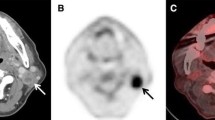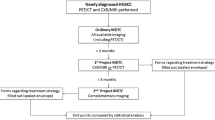Abstract
Objective
To evaluate the accuracy of PET/CT using 18F-fluorodeoxyglucose (FDG) with IV contrast for suspected recurrent head and neck squamous cell carcinoma (HNSCC).
Methods
One hundred and seventy patients previously treated for HNSCC underwent PET/CT, consisting of non-contrast-enhanced and contrast-enhanced CT, to investigate suspected recurrence. Diagnostic performance of PET/contrast-enhanced CT (PET/ceCT), PET/non-contrast-enhanced CT (PET/ncCT) and contrast-enhanced CT (ceCT) for local or regional recurrence, distant metastasis, overall recurrence and second primary cancer was evaluated. The reference standard included histopathology, treatment change and imaging follow-up.
Results
The patient-based areas under the receiver operating characteristic curves (AUC) for ceCT, PET/ncCT and PET/ceCT were 0.82, 0.96 and 0.98 for local recurrence, 0.73, 0.86 and 0.86 for regional recurrence, 0.86, 0.91 and 0.92 for distant metastasis, 0.72, 0.86 and 0.87 for overall recurrence, and 0.86, 0.89 and 0.91 for a second primary cancer. Both PET/ceCT and PET/ncCT statistically showed larger AUC than ceCT for recurrence, and the difference between PET/ceCT and PET/ncCT for local recurrence reached a significant level (p = 0.039). The accuracy of PET/ceCT for diagnosing overall recurrence was high, irrespective of the time interval after the last treatment (83.3–94.1 %).
Conclusion
FDG-PET/CT was a more accurate HNSCC restaging tool than ceCT. The added value of ceCT at FDG-PET/CT is minimal.
Key Points
• FDG-PET/CT is a more accurate post-treatment surveillance tool than ceCT for HNSCC.
• FDG-PET/ceCT was useful, irrespective of the time interval after the last treatment.
• FDG-PET/ceCT showed high negative predictive value and limited positive predictive value.
• The added value of ceCT at FDG-PET/CT is minimal and likely not clinically relevant.





Similar content being viewed by others
References
Ang KK, Trotti A, Brown BW et al (2001) Randomized trial addressing risk features and time factors of surgery plus radiotherapy in advanced head-and-neck cancer. Int J Radiat Oncol Biol Phys 51:571–578
Lell M, Baum U, Greess H et al (2000) Head and neck tumors: imaging recurrent tumor and post-therapeutic changes with CT and MRI. Eur J Radiol 33:239–247
Krabbe CA, Pruim J, Dijkstra PU et al (2009) 18F-FDG PET as a routine posttreatment surveillance tool in oral and oropharyngeal squamous cell carcinoma: a prospective study. J Nucl Med 50:1940–1947
Salaun PY, Abgral R, Querellou S et al (2007) Does 18fluoro-fluorodeoxyglucose positron emission tomography improve recurrence detection in patients treated for head and neck squamous cell carcinoma with negative clinical follow-up? Head Neck 29:1115–1120
Liu T, Xu W, Yan WL, Ye M, Bai YR, Huang G (2007) FDG-PET, CT, MRI for diagnosis of local residual or recurrent nasopharyngeal carcinoma, which one is the best? A systematic review. Radiother Oncol 85:327–335
Isles MG, McConkey C, Mehanna HM (2008) A systematic review and meta-analysis of the role of positron emission tomography in the follow up of head and neck squamous cell carcinoma following radiotherapy or chemoradiotherapy. Clin Otolaryngol 33:210–222
Gourin CG, Watts T, Williams HT, Patel VS, Bilodeau PA, Coleman TA (2009) Identification of distant metastases with PET-CT in patients with suspected recurrent head and neck cancer. Laryngoscope 119:703–706
Abgral R, Querellou S, Potard G et al (2009) Does 18F-FDG PET/CT improve the detection of posttreatment recurrence of head and neck squamous cell carcinoma in patients negative for disease on clinical follow-up? J Nucl Med 50:24–29
Kao J, Vu HL, Genden EM et al (2009) The diagnostic and prognostic utility of positron emission tomography/computed tomography-based follow-up after radiotherapy for head and neck cancer. Cancer 115:4586–4594
Gupta T, Master Z, Kannan S et al (2011) Diagnostic performance of post-treatment FDG PET or FDG PET/CT imaging in head and neck cancer: a systematic review and meta-analysis. Eur J Nucl Med Mol Imaging 38:2083–2095
Xu GZ, Guan DJ, He ZY (2011) 18FDG-PET/CT for detecting distant metastases and second primary cancers in patients with head and neck cancer. A meta-analysis. Oral Oncol 47:560–565
Beswick DM, Gooding WE, Johnson JT, Branstetter BF 4th (2012) Temporal patterns of head and neck squamous cell carcinoma recurrence with positron-emission tomography/computed tomography monitoring. Laryngoscope 122:1512–1517
Yi JS, Kim JS, Lee JH et al (2012) 18F-FDG PET/CT for detecting distant metastases in patients with recurrent head and neck squamous cell carcinoma. J Surg Oncol 106:708–712
Ho AS, Tsao GJ, Chen FW et al (2013) Impact of positron emission tomography/computed tomography surveillance at 12 and 24 months for detecting head and neck cancer recurrence. Cancer 119:1349–1356
Kim JW, Roh JL, Kim JS et al (2013) 18F-FDG PET/CT surveillance at 3-6 and 12 months for detection of recurrence and second primary cancer in patients with head and neck squamous cell carcinoma. Br J Cancer 109:2973–2979
Branstetter BF 4th, Blodgett TM, Zimmer LA et al (2005) Head and neck malignancy: is PET/CT more accurate than PET or CT alone? Radiology 235:580–586
Kostakoglu L, Fardanesh R, Posner M et al (2013) Early detection of recurrent disease by FDG-PET/CT leads to management changes in patients with squamous cell cancer of the head and neck. Oncologist 18:1108–1117
Rangaswamy B, Fardanesh MR, Genden EM et al (2013) Improvement in the detection of locoregional recurrence in head and neck malignancies: F-18 fluorodeoxyglucose-positron emission tomography/computed tomography compared to high-resolution contrast-enhanced computed tomography and endoscopic examination. Laryngoscope 123:2664–2669
McDermott M, Hughes M, Rath T et al (2013) Negative predictive value of surveillance PET/CT in head and neck squamous cell cancer. AJNR Am J Neuroradiol 34:1632–1636
Rabalais AG, Walvekar R, Nuss D et al (2009) Positron emission tomography-computed tomography surveillance for the node-positive neck after chemoradiotherapy. Laryngoscope 119:1120–1124
Jovanovic A, van der Tol IG, Kostense PJ et al (1994) Second respiratory and upper digestive tract cancer following oral squamous cell carcinoma. Eur J Cancer B Oral Oncol 30B:225–229
Coleman ER, Delbeke D, Guiberteau MJ et al (2005) Concurrent PET/CT with an integrated imaging system: intersociety dialogue from the joint working group of the American College of Radiology, the Society of Nuclear Medicine, and the Society of Computed Body Tomography and Magnetic Resonance. J Nucl Med 46:1225–1239
IAEA (2008) Radiation protection in newer medical imaging techniques: PET/CT (Safety Reports Series no. 58). http://www-pub.iaea.org/MTCD/publications/PDF/pub1343_web.pdf. Accessed 13 July 2015
Kuhn FP, Hüllner M, Mader CE et al (2014) Contrast-enhanced PET/MR imaging versus contrast-enhanced PET/CT in head and neck cancer: how much MR information is needed? J Nucl Med 55:551–558
Kubiessa K, Purz S, Gawlitza M et al (2014) Initial clinical results of simultaneous 18F-FDG PET/MRI in comparison to 18F-FDG PET/CT in patients with head and neck cancer. Eur J Nucl Med Mol Imaging 41:639–648
Koshkareva Y, Branstetter BF 4th, Gaughan JP, Ferris RL (2014) Predictive accuracy of first post-treatment PET/CT in HPV-related oropharyngeal squamous cell carcinoma. Laryngoscope 124:1843–1847
Acknowledgments
The scientific guarantor of this publication is Kazuro Sugimura M.D., Ph.D. The authors of this manuscript declare no relationships with any companies whose products or services may be related to the subject matter of the article. The authors state that this work has not received any funding. No complex statistical methods were necessary for this paper. Institutional review board approval was obtained. Written informed consent was waived by the institutional review board. Study subjects or cohorts have not been previously reported. Methodology: retrospective, diagnostic or prognostic study/observational, performed at one institution.
Author information
Authors and Affiliations
Corresponding author
Rights and permissions
About this article
Cite this article
Suenaga, Y., Kitajima, K., Ishihara, T. et al. FDG-PET/contrast-enhanced CT as a post-treatment tool in head and neck squamous cell carcinoma: comparison with FDG-PET/non-contrast-enhanced CT and contrast-enhanced CT. Eur Radiol 26, 1018–1030 (2016). https://doi.org/10.1007/s00330-015-3902-1
Received:
Revised:
Accepted:
Published:
Issue Date:
DOI: https://doi.org/10.1007/s00330-015-3902-1




